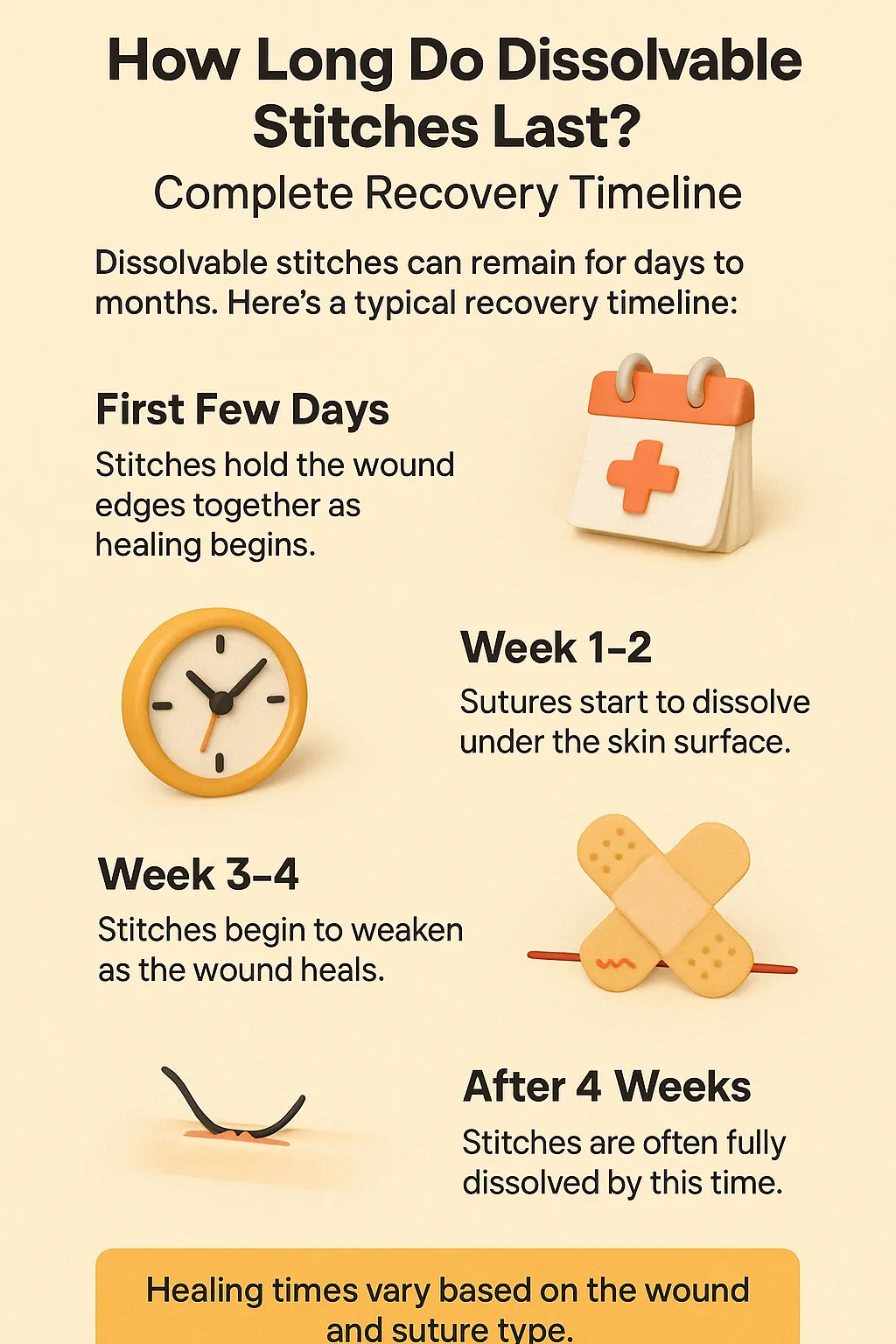How long do dissolvable stitches last? For anyone recovering from surgery or injury, there’s no universal answer. Based on patient experiences and clinical observations, these stitches can dissolve in as little as a few days or stay intact for several months. The variation comes down to the type of suture material, the wound’s location, the body’s healing rate, and the quality of aftercare.
This guide offers a clear recovery timeline, explains why absorption speeds vary, and shares examples that show how procedure type influences how long do dissolvable stitches last and how long your stitches remain.
Top Takeaways
- Material type, wound site, movement, and aftercare all impact the timeline.
- Good aftercare reduces complications and helps stitches perform effectively.
- Absorbable sutures are proven to be as safe as non-absorbable options when used appropriately.
- Educated patients tend to recover faster and with fewer problems.
Dissolvable Stitch Lifespan and Factors That Influence It
Dissolvable stitches, or absorbable sutures, are created to naturally break down inside the body, eliminating the need for removal. Depending on the material and location, they may last from 7 days up to 3 months.
- Fast-absorbing sutures — often used for surface closures — can dissolve within a week.
- Slow-absorbing sutures — typically used in deeper tissues — may hold for weeks or months.
The body’s enzymes and immune processes gradually break down the stitches. Keeping the wound clean, avoiding unnecessary strain, and following your healthcare provider’s instructions are all key to helping stitches dissolve within the intended time frame.
“After years of observing both patients and personal recoveries, I’ve seen that there’s no single timeline for dissolvable stitches. The right suture choice, placed in the right location, and paired with careful aftercare, makes all the difference in the healing process.”
Case Study & Real-World Examples
Fast Absorption – Oral Surgery
- Patient: 34 years old, post-wisdom tooth extraction.
- Dissolved in about 7 days due to high moisture and active enzymes in the mouth.
- Aftercare: Saltwater rinses, soft-food diet.
- Outcome: Smooth healing with no irritation.
Moderate Duration – Knee Arthroscopy
- Patient: 48 years old, active runner.
- Stitches lasted around 6 weeks due to joint motion and mild swelling.
- Aftercare: Supportive taping, gradual return to activity.
- Outcome: Wound protected and healing progressed steadily.
Slow Absorption – Abdominal Surgery
- Patient: 52 years old, with polydioxanone (PDS) sutures.
- Sutures held strength for about 8 weeks, fully dissolving in 3 months.
- Purpose: Provided long-term support for deep tissue healing.
- Aftercare: Strict cleaning and infection prevention measures.
Key Insight: Stitch lifespan varies significantly based on procedure type, suture material, and how the wound is managed.
Supporting Statistics
- Infection Risk: 1–3% of surgeries may experience infections (MedlinePlus – U.S. National Library of Medicine).
- Safety of Absorbable Sutures: Research shows no greater risk of infection or poor healing compared to non-absorbable sutures (American Academy of Family Physicians).
- Prevention Best Practices: Proper hygiene, wound protection, and monitoring are essential (Mayo Clinic).
Final Thought & Opinion
- Dissolvable stitches adapt to the specific needs of your body and the demands of your procedure.
- They may dissolve quickly or remain in place for months, and both can be normal depending on the context.
- Patients who understand their recovery process and follow aftercare advice closely tend to have smoother outcomes.
Next Steps
- Follow your provider’s aftercare instructions.
- Watch for redness, swelling, pain, or unusual discharge.
- Never try to remove stitches yourself.
- Maintain a balanced diet and stay hydrated.
- Attend all follow-up appointments.
- Use trusted medical sources for information.
Frequently Asked Questions
How long do dissolvable stitches last?
Usually 4–8 weeks, but they can last longer or dissolve sooner depending on the situation.
Why does stitch duration vary?
It depends on suture material, wound location, movement, and your body’s healing rate.
Do certain procedures need longer-lasting stitches?
Yes. Surgeries in deeper tissues or high-stress areas may require slow-absorbing sutures for extended support.
What if my stitches don’t dissolve?
See your healthcare provider. Do not try to remove them yourself.
How can I promote healthy healing?
Follow your aftercare plan for skіn ulсеrs, protect the wound, and maintain good nutrition.
When exploring How Long Do Dissolvable Stitches Last? Complete Recovery Timeline, it’s helpful to draw parallels with other situations where timelines and maintenance make a big difference. Just as using the right air filter size—like the 17.25x35.25x1 Air Filters—ensures your HVAC runs smoothly, choosing the right suture material impacts how long stitches remain in place. Much like scheduling regular care with HVAC Tune-Up Companies, consistent wound monitoring can prevent complications. Quality components such as the 14x20x1 Pleated Furnace Filters or the 19x19x1 MERV 8 Pleated HVAC AC Furnace Air Filters show how proper fit and quality materials extend performance, just as optimal stitch selection supports healing. Even practical finds, like those on eBay, remind us that the right tools and timely intervention lead to the best long-term results.









